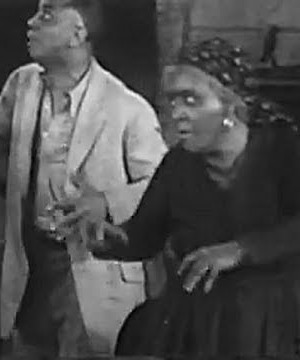
Tom Catt (Morris McKenny) has returned to rural Louisiana, with plans to carry out that are both immoral and illegal. Top on his list is blackmailing the upright preacher, Amos Berry (J. Augustus Smith), who has a secret indiscretion in his past that Catt threatens to make public. He’s nearly as interested in turning the preacher’s niece, Myrtle (Edna Barr) into a prostitute. The locals only way of dealing with Catt is to turn to Autie Hagar (Laura Bowman), the Voodoo woman, whose nephew, Ebenezer (Lionel Monagas) is in love with Myrtle, and has turned against Voodoo.
Drums o’ Voodoo, also known as Voodoo, Voodoo Drums, She Devil, and Louisiana, is not a horror film, but as a Voodoo film, it’s part of the discussion of early horror. It’s a race picture (very low budget films made by nearly all Black casts and mostly Black crews to be shown for Black audiences) based on star J. Augustus Smith’s stage play, Louisiana. That makes Drums o’ Voodoo the first film based on a work of a Black playwright. The play had a very limited run, summing the wrath of New York critics. Smith found a producer, who, as was generally the case with race pictures, was White, who then hired short-time White director Arthur Hoerl, who is better known as the writer of Reefer Madness.
They ported the play over mostly intact, including a majority of the cast and the set designs. Drums o’ Voodoo is closer to a recorded play than a typical movie. The backdrops are obviously painted flats, the camera seldom moves, and everyone speaks toward the same direction. All of that is less of a problem than you might think. A majority of the race pictures I’ve seen have had such poor camerawork that it’s an improvement to park it, and the acting may be overly theatrical, but that’s its main downside, which is a step up from actor’s emotionlessly reciting words they don’t understand. Taken for what it is, it’s not bad.
And there’s a lot to like in the story. Mixing Christianity with Voodoo creates some nice philosophical and character moments. Drums o’ Voodoo isn’t negative about Voodoo. Christianity has its good points, but for dealing with terrible people, sometimes you need Voodoo. The preacher and the Voodoo woman are on friendly terms and work together more often than not, while Ebenezer’s desire to get away from Voodoo purely for social acceptance presents lots of interesting possibilities. It’s refreshing.
There are a few odd makeup choices that may have had meaning in the 1930s that escapes me. Laura Bowman wears Blackface, except she’s Black. Did they think she was too pale for a Voodoo priestess? It’s noticeable. Far more noticeable is James Davis as Brother Zero (listed as Brother Zumee on IMDB) who also is a Black actor—though I can’t confirm that—who is in full mistral show Blackface. No one else is. Since he’s both an ass and a comical character, I assume that his look was to indicate he was a fool, but now it’s just strange.
Unfortunately there is one insurmountable problem with Drums o’ Voodoo. It was lost for fifty years, and when found, it wasn’t in good shape. Nearly twenty minutes are missing, including most of the climax. Enough exists to explain what happens to everyone, but some needed details are gone. It makes for a very unsatisfying conclusion. I’ve found no evidence for their being a complete copy of the film.